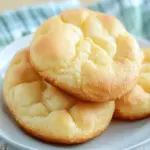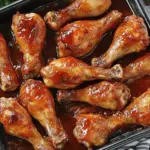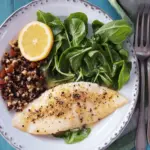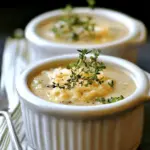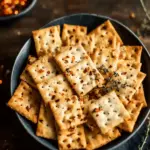This cheesecake boasts a perfectly smooth and creamy texture, resting on a buttery graham cracker crust that adds just the right amount of crunch. Its golden edges and luscious interior make it a timeless dessert that’s as visually appealing as it is delicious.
What makes this cheesecake stand out is its versatility serve it plain for a classic experience, or top with fresh berries, chocolate ganache, or caramel sauce to suit your mood and occasion. Whether for a family gathering or a quiet treat at home, it’s the perfect indulgence that everyone loves.
Full Recipe
Ingredients:
-
2 ½ cups graham cracker crumbs
-
⅓ cup granulated sugar
-
1 teaspoon ground cinnamon
-
½ cup unsalted butter, melted
-
4 (8 oz) packages cream cheese, softened
-
1 ¼ cups granulated sugar
-
1 teaspoon vanilla extract
-
4 large eggs
-
1 cup sour cream
-
2 tablespoons all-purpose flour
Directions:
-
Preheat oven to 325°F (163°C).
-
In a medium bowl, mix graham cracker crumbs, sugar, and cinnamon. Stir in melted butter until combined. Press mixture firmly into the bottom of a 9-inch springform pan to form the crust. Set aside.
-
In a large bowl, beat softened cream cheese with a hand mixer until smooth and creamy. Gradually add sugar and vanilla extract, mixing well.
-
Add eggs one at a time, beating on low speed after each addition just until blended. Avoid overmixing.
-
Blend in sour cream and flour until smooth and combined.
-
Pour the cream cheese mixture over the crust in the springform pan.
-
Bake for 55-65 minutes, or until the center is almost set but still slightly jiggly.
-
Turn off oven and leave the cheesecake inside with the door slightly ajar for 1 hour to prevent cracking.
-
Remove cheesecake and cool completely at room temperature. Then refrigerate for at least 4 hours or overnight before serving.
Prep Time: 20 minutes | Cooking Time: 1 hour 5 minutes | Total Time: 5 hours 25 minutes (including chilling)
Kcal: Approximately 450 kcal per serving | Servings: 12 serving
The Timeless Appeal of Classic Homemade Cheesecake
Cheesecake is one of those rare desserts that feels both indulgent and comforting at the same time. Its creamy texture, rich flavor, and buttery crust make it a favorite in kitchens and bakeries all around the world. Among the many variations, the Classic Homemade Cheesecake often known as New York Style Cheesecake holds a special place in dessert lore due to its smooth, dense consistency and perfectly balanced flavor. Whether you’re a seasoned baker or a beginner, mastering this recipe offers a rewarding culinary experience and a guaranteed crowd-pleaser.
The History and Origins of Cheesecake
Cheesecake has a long and fascinating history dating back to ancient times. The earliest recorded cheesecake-like dishes come from Greece around 230 A.D., where a simple mix of cheese, flour, and honey was baked and served to athletes during the first Olympic games. From there, it spread through the Roman Empire and evolved as cultures added their own twists.
The version we recognize today as cheesecake, especially the New York style, gained prominence in the United States in the early 20th century. The addition of cream cheese, invented in New York in the late 1800s, became a defining feature, giving the cake its uniquely creamy texture and tangy flavor. Over time, the New York style became synonymous with dense, rich, and creamy cheesecakes, often served plain or with simple toppings to showcase its luxurious texture.
What Makes a Classic Cheesecake “Classic”?
The hallmark of a classic cheesecake is its simplicity. It’s not overwhelmed by fancy toppings or extra flavors but relies on a few quality ingredients and careful technique. Cream cheese provides the silky smooth base, while eggs contribute structure and richness. Sour cream or heavy cream is often included to add moisture and a subtle tang. The crust, typically made from graham cracker crumbs mixed with butter and sugar, provides a crunchy contrast to the creamy filling.
Unlike lighter cheesecakes or no-bake versions, the classic baked cheesecake has a dense yet creamy texture that holds its shape when sliced, making it ideal for presentation. Achieving this texture requires careful mixing to avoid incorporating too much air, and baking at a low temperature to prevent cracks on the surface. The final step of letting the cake cool gradually helps ensure a perfectly smooth top.
Why Make Cheesecake at Home?
While it might be tempting to buy a cheesecake from the store or bakery, making your own at home comes with many benefits. First, homemade cheesecake allows you to control the quality of your ingredients. Using full-fat cream cheese and fresh eggs gives you a richer, more decadent result than many commercial options which often rely on stabilizers or preservatives.
Second, baking cheesecake yourself means you can customize it to your taste. Want it a bit tangier? Add more sour cream or lemon zest. Prefer a lighter texture? You can experiment with ingredient ratios. Craving a gluten-free crust? Swap the graham crackers for almond flour or gluten-free biscuits.
Finally, homemade cheesecake is a wonderful way to impress guests or celebrate special occasions. The process of baking it from preparing the crust to patiently cooling the cake creates a sense of anticipation and achievement. And nothing beats serving a slice of creamy cheesecake that you made with your own hands.
Tips for Perfect Cheesecake Every Time
Even though this recipe is straightforward, some little techniques make a big difference in the final outcome:
-
Room Temperature Ingredients: Always soften your cream cheese and eggs before mixing. Cold ingredients can cause lumps and prevent smooth blending.
-
Avoid Overmixing: Whisk just until combined to avoid adding excess air, which can cause cracks or a spongy texture.
-
Water Bath Technique: Although this particular recipe does not require it, many bakers prefer baking the cheesecake in a water bath to maintain a moist, gentle baking environment and prevent cracking.
-
Cooling Gradually: After baking, letting the cheesecake cool slowly inside the oven with the door ajar helps avoid temperature shocks that cause cracks.
-
Chill Properly: Refrigerate the cheesecake for several hours or overnight to let the flavors develop and the texture set perfectly before slicing.
Variations and Serving Ideas
Once you have mastered the classic recipe, the possibilities for variation are endless. Some popular twists include:
-
Fruit Toppings: Fresh berries, cherries, or sliced peaches add a fresh, tangy contrast to the rich cake.
-
Sauces: Drizzle with caramel, chocolate ganache, or berry coulis to elevate the presentation.
-
Flavor Additions: Incorporate lemon zest, vanilla bean, or even a swirl of pumpkin puree or chocolate into the batter.
-
Crust Alternatives: Try crushed Oreos, digestive biscuits, or nut-based crusts for different textures and flavors.
-
Mini Cheesecakes: Make individual portions using muffin tins for easy serving and party-friendly desserts.
Serving cheesecake with a dollop of whipped cream, a sprinkle of toasted nuts, or a side of espresso or dessert wine makes for a complete, indulgent dessert experience.
The Nutritional Side of Cheesecake
Cheesecake is undeniably a rich dessert, typically high in calories and fat due to its cream cheese and butter content. However, enjoyed in moderation, it can be part of a balanced diet. Using quality ingredients and homemade preparation means avoiding many additives and preservatives found in commercial products.
For those mindful of nutrition, some lighter alternatives include using reduced-fat cream cheese, Greek yogurt instead of sour cream, or a nut-based crust instead of graham crackers. Still, the classic cheesecake remains a treat best savored occasionally and appreciated fully.
The Joy of Sharing Cheesecake
One of the best things about cheesecake is how universally loved it is. It transcends cultures and generations, often appearing at celebrations such as birthdays, holidays, weddings, and dinner parties. The effort put into making a cheesecake is a gesture of care and hospitality that does not go unnoticed.
Whether you serve it plain or decorated, a homemade cheesecake brings people together around the table, sharing stories, laughter, and satisfaction with every bite.
Conclusion:
Classic homemade cheesecake is more than just a dessert; it’s a culinary tradition that embodies comfort, celebration, and timeless elegance. Its smooth, creamy texture paired with a buttery crust creates an irresistible combination that has delighted palates for centuries. With simple ingredients and straightforward techniques, anyone can create a perfect cheesecake at home, customized to their own tastes and preferences.
Baking this cheesecake yourself is a rewarding experience that results in a luxurious dessert fit for any occasion. Whether served plain or adorned with fresh fruits or decadent sauces, it promises to be the highlight of any meal and the centerpiece of joyful moments shared with family and friends.
So why not embrace the art of cheesecake making and add this classic to your baking repertoire? With practice, patience, and quality ingredients, you’ll be slicing into creamy perfection and making sweet memories that last.


